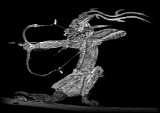

Preparing to Use a Ju Yuan Hao Horn Bow
This guide is intended for those who have received a new horn bow made by Ju Yuan Hao of Peking and who may not have experience of handling horn bows.
Ju Yuan Hao bows are craftsman items. Each one is different from the other. They cannot be guaranteed other than against gross defects in craftsmanship and construction.
The bow comes with a traditional, Chinese silk string. The string is appropriate for initial setting-up and for display purposes; but it may be less suitable for normal shooting than a lighter-weight dacron string.
This is how the bow looks when you get it. It is possible for one or both string bridges to come off during transportation or during use. They can be glued back with strong wood glue and left clamped overnight.

It is not 'C'-shaped because Ju Yuan Hao does not want them to be too difficult to string, thus avoiding breakage before it is even successfully strung for the first time.
It is important to do the stringing correctly. However impatient you feel to string it up, DO NOT try a step-through on your own to string it.
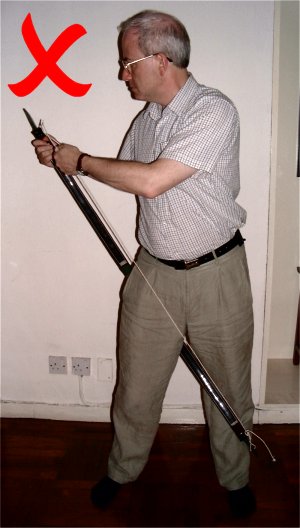
DON'T DO THIS
To string a Chinese horn bow requires two people. Do not use methods used for Korean or Turkish bows as they are for use with much smaller bows.
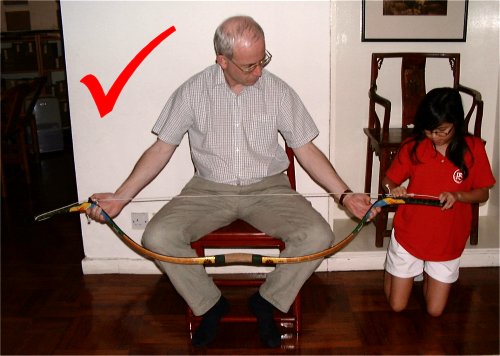
The correct way to string a Chinese horn bow.
Before you start, place the loop into the string nock at one end, run it over the string bridge and secure it in place with your thumb. Show your helper how it is supposed to look first, before trying to start stringing. Do not let your helper get in front of the bow limb. Keep him/her behind the siyah. Use a chair or stool with a low seat and no arms.
Place your knees halfway along the horn of the limb: not near the
grip. Get your helper to keep the string gently taught and get it clear of your
knees. Pull back the limbs from below the base of the siyahs.
Relax and pull back as far as your helper needs to get the string loop over the tip, onto the string nock and over the string bridge. The limb is not going to break like this, so do not get nervous or shake. You may hear a slight creaking: this is normal with natural materials.
Get you helper to double-check that the loops are secure in both string-nocks before you let the bow relax into the strung position.
Ju Yuan Hao has made the string too long, so that stringing for the first time will not be too difficult. But the brace-height will be too low for shooting. Later, you need to adjust the brace-height. First, though, check the alignment of the siyahs. Mostly, they will be a little bit out of alignment.

Wrong way to check alignment.
It is no good checking the alignment from the belly side. You must check it from the back:
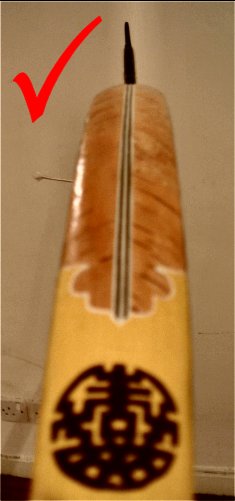
Right way to check alignment
Check both ends. A slight mis-alignment of the siyahs does not matter. Pull back the string about 30-40 cm and let it come back smartly onto the string bridges without actually releasing it. If the string readily comes back to the centre of the bridges, it is alright. If you think the siyahs are too far out of alignment -
keep the string on,
use a hairdryer to warm the limb from the horn side over the whole length of the horn,
it only needs to be warm to the touch: not hot,
then twist the siyah gently in the required direction and allow it to cool.
To adjust the brace height, you will need to take the string off the bow and loosen a knot at one end. (Do not untie the knot completely!)

tight knot

loose knot
Try to keep the loop the same size and take up about 4cm from the main part of the string, through the loop and into the loose end. Then re-tighten the knot and string the bow again. This can be a long session of trial-and-error; but it only needs to be done once.
The correct brace-height should leave the bow looking like this:

Correct brace-height.
There is a slight variation between the top and bottom limbs, to compensate for the fact that the arrow passes above the centre of the grip. In this photograph, the top of the bow is on the right and the bottom on the left.
If you are going to use your bow for regular shooting, then the authentic string supplied is too heavy and will result in a weak shot. Use around 20 loops of regular dacron bow-string, measured against the original string after correcting the brace height. Whip about 6cm at the top of each loop and unite the loops level with the knot of the original string, with an extra whipping layer adjacent to the bridges.
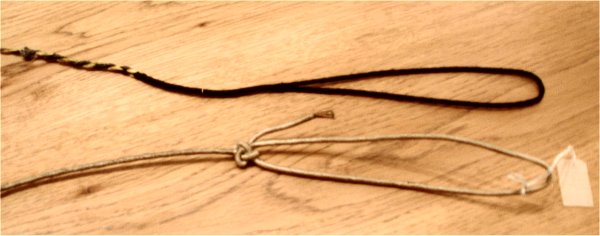
Traditional string and dacron string for shooting.
The Ju Yuan Hao bow has been lacquered, so it will withstand temporary moisture. If it gets wet, it should be dried immediately with a dry cloth and placed in a warm, dry room to dry off completely. When not in use, it should be kept un-strung in its cloth bag, in a dry room. If you have warmed it for any reason or it has been in direct sunlight, it should be allowed to cool down before shooting. Do not allow it to remain in strong sunlight near windows or in a car.
The bow can only be bent in the direction of the draw. Never put any tension against the direction of the draw. After shooting, there will be some set in the limbs. This will relax out when the bow is unstrung and cool.
The bow can be drawn to 33". Do not be alarmed if there is a creaking sound near full draw: that is normal for sinew bows. Check the string nocks and string bridges after each round of shooting in case of deflexion of the siyahs or any problem with the string bridges.
Although you can use a Mediterranean draw, you should be careful to avoid twisting the bow as you draw. Let the grip rest against the web of the bow-hand thumb and only grip lightly. The bow shoots ideally at 32" with a Mongolian draw and will be rather under-powered with a Mediterranean draw at 28".